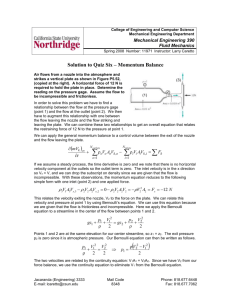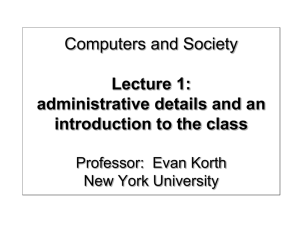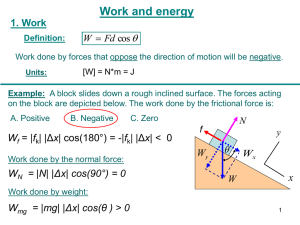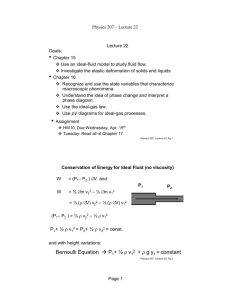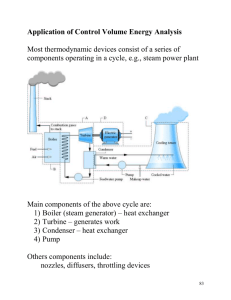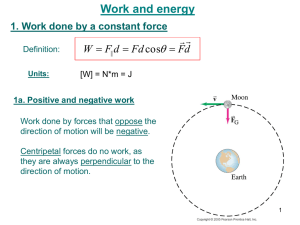Diapositivo 1 - Departamento de Ciência de Computadores
advertisement
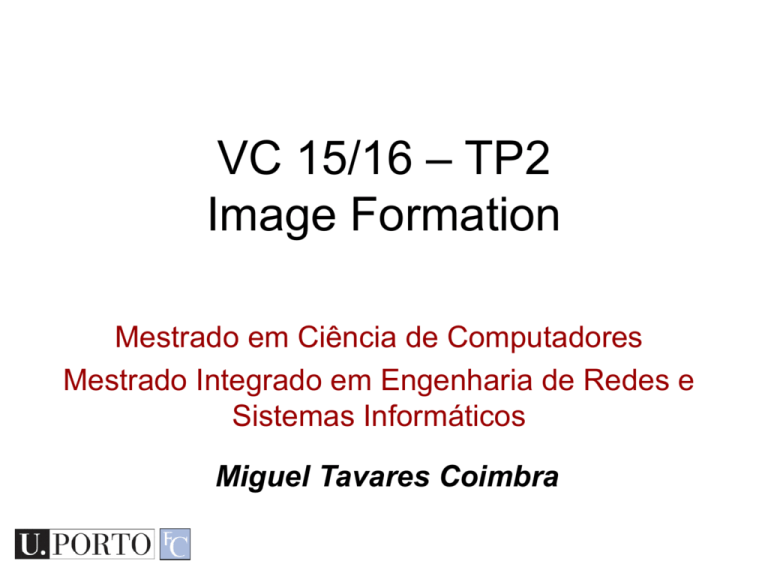
VC 15/16 – TP2 Image Formation Mestrado em Ciência de Computadores Mestrado Integrado em Engenharia de Redes e Sistemas Informáticos Miguel Tavares Coimbra Outline • ‘Computer Vision’? • The Human Visual System • Image Capturing Systems Acknowledgements: Most of this course is based on the excellent courses offered by Prof. Shree Nayar at Columbia University, USA and by Prof. Srinivasa Narasimhan at CMU, USA. Please acknowledge the original source when reusing these slides for academic purposes. VC 15/16 - TP2 - Image Formation Topic: Computer Vision? • ‘Computer Vision’? • The Human Visual System • Image Capturing Systems VC 15/16 - TP2 - Image Formation Computer Vision “The goal of Computer Vision is to make useful decisions about real physical objects and scenes based on sensed images”, Shapiro and Stockman, “Computer Vision”, 2001 VC 15/16 - TP2 - Image Formation Components of a Computer Vision System Camera Lighting Computer Scene Scene Interpretation VC 15/16 - TP2 - Image Formation Topic: The Human Visual System • ‘Computer Vision’? • The Human Visual System • Image Capturing Systems VC 15/16 - TP2 - Image Formation Our Eyes Iris Pupil Sclera Cornea -Iris is the diaphragm that changes the aperture (pupil) -Retina is the sensor where the fovea has the highest resolution VC 15/16 - TP2 - Image Formation Focusing shorter focal length Changes the focal length of the lens VC 15/16 - TP2 - Image Formation Myopia and Hyperopia (myopia) VC 15/16 - TP2 - Image Formation Astigmatism The cornea is distorted causing images to be un-focused on the retina. VC 15/16 - TP2 - Image Formation Blind Spot in the Eye Close your right eye and look directly at the “+” VC 15/16 - TP2 - Image Formation Colour • Our retina has: – Cones – Measure the frequency of light (colour) • 6 to 7 millions • High-definition • Need high luminosity – Rods – Measure the intensity of light (luminance) • 75 to 150 millions • Low-definition • Function with low luminosity Gonzalez & Woods We only see colour in the center of our retina! VC 15/16 - TP2 - Image Formation Topic: Image Capturing Systems • ‘Computer Vision’? • The Human Visual System • Image Capturing Systems VC 15/16 - TP2 - Image Formation A Brief History of Images 1544 Camera Obscura, Gemma Frisius, 1544 VC 15/16 - TP2 - Image Formation A Brief History of Images 1544 1568 Lens Based Camera Obscura, 1568 VC 15/16 - TP2 - Image Formation A Brief History of Images 1544 1568 1837 Still Life, Louis Jaques Mande Daguerre, 1837 VC 15/16 - TP2 - Image Formation A Brief History of Images 1544 1568 1837 Silicon Image Detector, 1970 1970 VC 15/16 - TP2 - Image Formation A Brief History of Images 1544 1568 1837 Digital Cameras VC 15/16 - TP2 - Image Formation 1970 1995 Components of a Computer Vision System Camera Lighting Computer Scene Scene Interpretation VC 15/16 - TP2 - Image Formation Pinhole and the Perspective Projection Is an image being formed on the screen? (x,y) screen YES! But, not a “clear” one. scene image plane r ( x, y , z ) y optical axis effective focal length, f’ z pinhole x r ' ( x' , y ' , f ' ) VC 15/16 - TP2 - Image Formation r' r f' z x' x f' z y' y f' z Pinhole Camera • Basically a pinhole camera is a box, with a tiny hole at one end and film or photographic paper at the other. • Mathematically: out of all the light rays in the world, choose the set of light rays passing through a point and projecting onto a plane. VC 15/16 - TP2 - Image Formation Pinhole Photography ©Charlotte Murray Untitled, 4" x 5" pinhole photograph, 1992 Image Size inversely proportional to Distance Reading: http://www.pinholeresource.com/ VC 15/16 - TP2 - Image Formation Magnification y f’ optical axis d’ image plane B’ Pinhole A’ x planar scene A' ( x' , y ' , f ' ) B' ( x'x' , y 'y ' , f ' ) y' y f' z x'x' x x f' z A( x, y, z ) B( x x, y y, z ) A z From perspective projection: x' x f' z d B Magnification: d' m d y 'y ' y y f' z VC 15/16 - TP2 - Image Formation (x' ) 2 (y ' ) 2 (x) 2 (y ) 2 Areaimage Areascene m2 f' z Image Formation using Lenses • Lenses are used to avoid problems with pinholes. • Ideal Lens: Same projection as pinhole but gathers more light! o i P P’ f • Gaussian Thin Lens Formula: 1 1 1 i o f • f is the focal length of the lens – determines the lens’s ability to refract light VC 15/16 - TP2 - Image Formation Focus and Defocus aperture Blur Circle, aperture diameter b d o i i' • Gaussian Law: 1 1 i o 1 1 i ' o' 1 f 1 f o' f f (i 'i) (o o' ) (o' f ) (o f ) • In theory, only one scene plane is in focus. VC 15/16 - TP2 - Image Formation Depth of Field • Range of object distances over which image is sufficiently well focused. • Range for which blur circle is less than the resolution of the sensor. http://images.dpchallenge.com/images_portfolio/27920/print_preview/116336.jpg VC 15/16 - TP2 - Image Formation Chromatic Aberration longitudinal chromatic aberration (axial) VC 15/16 - TP2 - Image Formation transverse chromatic aberration (lateral) Image Sensors • Considerations • Speed • Resolution • Signal / Noise Ratio • Cost VC 15/16 - TP2 - Image Formation Image Sensors • Convert light into an electric charge CCD (charge coupled device) Higher dynamic range High uniformity Lower noise CMOS (complementary metal Oxide semiconductor) Lower voltage Higher speed Lower system complexity VC 15/16 - TP2 - Image Formation CCD Performance Characteristics • Linearity Principle: Incoming photon flux vs. Output Signal • Sometimes cameras are made non-linear on purpose. • Calibration must be done (using reflectance charts)---covered later • Dark Current Noise: Non-zero output signal when incoming light is zero • Sensitivity: Minimum detectable signal produced by camera VC 15/16 - TP2 - Image Formation Sensing Brightness Incoming light has a spectral distribution So the pixel intensity becomes I k q p d VC 15/16 - TP2 - Image Formation p How do we sense colour? • Do we have infinite number of filters? rod cones Three filters of different spectral responses VC 15/16 - TP2 - Image Formation Sensing Colour • Tristimulus (trichromatic) values I R , I G , I B Camera’s spectral response functions: hR , hG , hB hB hG I R k hR p d hR I G k hG p d I B k hB p d VC 15/16 - TP2 - Image Formation Sensing Colour 3 CCD light beam splitter Bayer pattern Foveon X3TM VC 15/16 - TP2 - Image Formation Resources • J.C. Russ – Chapters 1 and 2 • L. Shapiro, and G. Stockman – Chapter 1 • “Color Vision: One of Nature's Wonders” in http://www.diycalculator.com/spcvision.shtml VC 15/16 - TP2 - Image Formation
